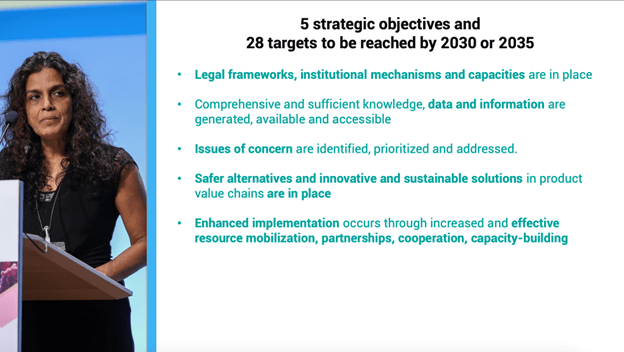Published January 31, 2024
By Giulia Carlini, Manager and Senior Attorney in CIEL’s Environmental Health program, David Azoulay, Director of the Environmental Health Program, and Catherine Allary, Communications Campaign Specialist.
After years of negotiations, the fifth International Conference on Chemicals Management (ICCM5) successfully adopted a new global framework on September 30, 2023, in Bonn, Germany, named the “Global Framework on Chemicals (GFC) – For a planet free of harm from chemicals and waste.”
Its predecessor — the Strategic Approach to International Chemicals Management (SAICM)— played a pivotal role in shaping this framework. However, SAICM’s original goal, which aimed to ensure the responsible management of all chemicals by 2020 and minimize risks to both the environment and human health, was not met, leading to the negotiation of this new Framework.
The adoption of the new Global Framework on Chemicals marks a historic moment in the ongoing international efforts toward a toxic-free planet.
The Evolution of SAICM: A Journey Through Key Milestones
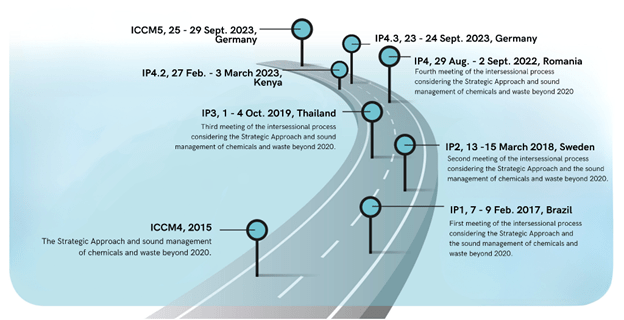 |
The road to adopting the new framework was long and fraught with obstacles, particularly when negotiations came to an unexpected halt, and ICCM5 was postponed for three years, due to the global COVID-19 pandemic.
SAICM’s history started in 2006:key milestones included identifying Emerging Policy Issues (EPIs) and Issues of Concern (IoC) for cooperative action —like chemicals in products, endocrine-disrupting chemicals, and highly hazardous pesticides.
However, as the international community realized that SAICM’s 2020 goal was far from reach, an Intersessional Process (IP) was launched in 2017, aimed to draft a new framework ‘beyond 2020.’
Adoption of a New Global Framework
What does this include?
The newly adopted Global Framework on Chemicals is a comprehensive initiative designed to cover the entire chemical lifecycle, including products and waste, emphasizing a “life cycle approach,” advocating for responsible management, and allowing flexibility for future instruments. It encompasses various objectives and targets related to transparency and sustainability, particularly those relevant to the Plastic Treaty.
This framework comprises three main sets of documents: the core text of the new framework, a high-level declaration known as the ‘Bonn Declaration,’ and 11 accompanying resolutions.
The Framework
The Framework consists of five strategic objectives and 28 targets to be achieved by 2030 or 2035, serving as a roadmap for collective action by countries and stakeholders, focusing on managing chemicals across their lifecycle, including products and waste.
The five objectives of the Global Framework on Chemicals encompass:
- Importance of legal frameworks: Establishment of legal frameworks, institutional mechanisms, and capacities.
- Comprehensive knowledge: Generation, availability, and accessibility of comprehensive and sufficient knowledge, data, and information.
- Progress on Issues of Concern: Identification, prioritization, and addressing of ‘issues of concern’.
- Promotion of safer alternatives: Promotion of safer and sustainable alternatives in product value chains and responsible chemical management across various sectors, including industry, agriculture, and healthcare, while enhancing transparency and access to information regarding chemical risks.
- Enhanced implementation: through increased and effective resource mobilization, partnerships, cooperation, and capacity-building.
Notably, the Global Framework emphasizes the importance of supporting the implementation of national legal frameworks. Additionally, it includes a specific target related to the phaseout of highly hazardous pesticides in agriculture by 2035, aligning with the broader objective of minimizing risks associated with these substances.
The Framework highlights an integrated financing approach, including mainstreaming, private sector financing, and external financing through a dedicated Global Framework for Chemicals Fund managed by UNEP. The Global Environment Facility (GEF) is urged to increase funding for the Framework.
A significant feature of the new Framework, like its predecessor SAICM, is its inclusive, multi-stakeholder, and multi-sectoral approach. It aims to ensure representation from various sectors, including governments, international organizations, and representatives of industry and public interest groups, as well as representatives from areas such as environment, health, agriculture, and labor. All stakeholders participate on equal footing in both negotiations and implementation processes.
The Bonn Declaration
A high-level declaration—the ‘Bonn Declaration’— recognizes that chemical pollution contributes to millions of deaths, illnesses and disabilities each year. It emphasizes that effective management of chemicals and waste will significantly contribute to achieving the objectives of the Paris Agreement on climate, and the goals and targets of the Kunming-Montreal Global Biodiversity Framework. The declaration commits to preventing exposure to harmful chemicals, phasing out the most dangerous substances, and protecting and respecting human rights for the well-being of present and future generations.
Main Resolutions
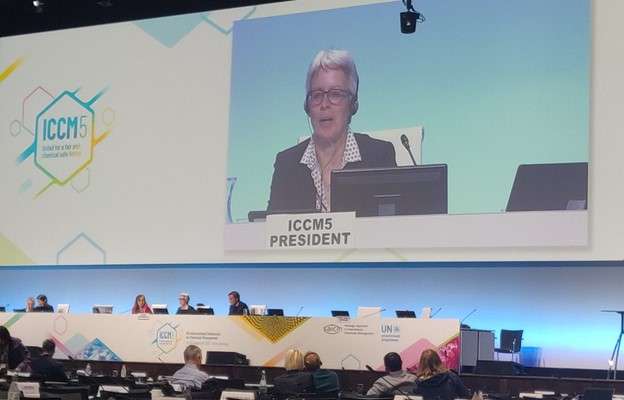
Resolutions adopted together with the new framework at ICCM5 include:
1) Addressing Issues of Concern (IOCs): ICCM5 decided that all pre-existing EPIs and IOCs identified under SAICM should temporarily be classified as “issues of concern” under the new Framework. Stakeholders were strongly encouraged to continue their efforts on these topics, with progress reports and a decision on future actions scheduled for the next Conference in 2026 (TBC). This proactive approach recognizes the ongoing struggle to address critical issues such as chemicals in products, PFAS, and endocrine-disrupting chemicals. However, it also underscores that more work is needed to fully address these concerns, highlighting the need for concrete actions and continued efforts during future negotiations to keep these issues on the global agenda until they are truly addressed.
2) Chemicals Financing Resolution: Funding has always been a contentious issue in chemical management. The stark disparity in funding needs was evident with Stockholm, which dealt with only a dozen of chemicals, requiring a budget 100 times greater than what was available for SAICM despite its broader scope, encompassing hundreds of chemicals.
The Quick Start Programme (QSP), which supported enabling activities under the old SAICM played a pivotal role. To address the issue in a more systematic way, an “integrated approach” to the financing of the chemical and waste sector was developed, emphasizing three pillars:
- ➔ mainstreaming chemical and waste issues into development assistance.
- ➔ private sector participation.
- ➔ and external donor finance.
Following the conclusion of the time-limited QSP, a new mechanism referred to as the Special Programme emerged, providing funding not only for SAICM but also for other conventions within the chemical and waste cluster, including the Basel, Stockholm, Rotterdam, and Minamata Conventions.
Negotiations in Bonn included proposals for a new global fund to address chemicals and waste, mirroring the Green Climate Fund and Global Biodiversity Fund. This Fund would have set a quantifiable goal for financial mobilization, implemented a global levy on basic chemicals, and introduced reforms of both the special programs and Global Environment Facility. However, after extensive late-night and tense negotiations, most of these proposals did not survive. Instead, a Trust Fund resembling the QSP was established, incorporating remaining funds from the original SAICM trust fund, along with pledges from Germany and France. Additionally, It was agreed to initiate a study to determine overall financing needs, which would inform the future establishment of targets and sound strategies for funding mobilization.
3) A New Alliance on Highly Hazardous Pesticides (HHPs): Proposed by the African region, this resolution endorses the newly-created global alliance dedicated to addressing Highly Hazardous Pesticides. The primary objective of this alliance is to take concrete steps toward phasing out HHPs and actively support the implementation of the relevant targets outlined in the new Framework. Furthermore, this alliance will play an instrumental role in identifying and advocating for safer and more sustainable agricultural practices, such as agroecology. It will also extend assistance to low- and middle-income countries in enhancing their regulatory frameworks for more effective HHPs management. As part of its mandate, the alliance is tasked with formulating an action plan and providing progress reports at forthcoming conferences, ensuring accountability and continuous advancement in HHPs management efforts.
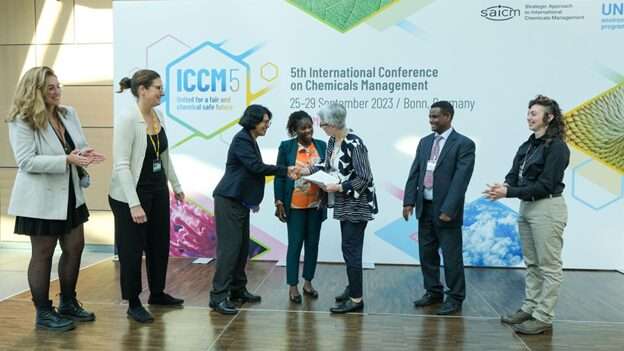
The Global Alliance on Highly Hazardous Pesticides was formed under the Food and Agriculture Organization (FAO), United Nations Environment Programme (UNEP), World Health Organization (WHO), United Nations Development Programme (UNDP), and International Labour Organization (ILO) auspices.
4) Gender Equality and Human Rights: While the framework’s language on human rights may not be as strong as desired, it recognizes the importance of sound chemical management in upholding human rights and well-being. A resolution on gender equality, proposed by Mexico and co-sponsored by CIEL and other partners, requests the development of a gender action plan for consideration by the next Conference to advance towards full, equal, and meaningful participation by all women in decision-making, and to promote gender-responsive policies.
Read the list of ICCM5 resolutions (advance).
Challenges and Key Issues
Negotiations 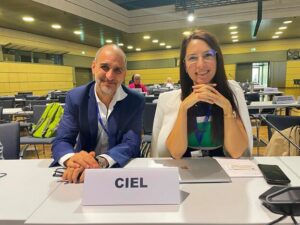 during ICCM5 faced various challenges, including differing visions for the Framework, debates on ambitious targets, and disagreements on financial considerations. Balancing high ambition with practicality was difficult, especially in target wording. The issue of financing generated considerable debate, with some—like the African region, CIEL, and IPEN—advocating for the operationalization of the polluter pays principle through a “globally coordinated fee” on basic chemicals, while others opposed this approach. Financial discussions were contentious, with donor countries hesitant to commit to increasing financial contributions while recipient countries pressed for much needed funding.
during ICCM5 faced various challenges, including differing visions for the Framework, debates on ambitious targets, and disagreements on financial considerations. Balancing high ambition with practicality was difficult, especially in target wording. The issue of financing generated considerable debate, with some—like the African region, CIEL, and IPEN—advocating for the operationalization of the polluter pays principle through a “globally coordinated fee” on basic chemicals, while others opposed this approach. Financial discussions were contentious, with donor countries hesitant to commit to increasing financial contributions while recipient countries pressed for much needed funding.
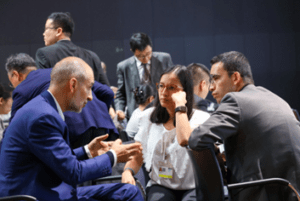
In the dynamic arena of international negotiations, addressing diverse interests, extensive tasks, and differing visions is a formidable challenge. However, ICCM5 provided a platform for stakeholders to grapple with these complexities. It underscored the importance of collaboration, transparency, and the commitment to safeguarding human health and the environment as the global community charts its course in chemical and waste management. Despite the challenges and eventual shortcomings, the conference set the stage for a promising future in this critical field.
Implications for the Plastic Treaty Negotiations:
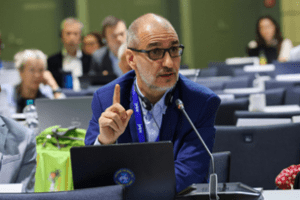
The adoption of the Global Framework on Chemicals has implications for other international agreements and negotiations, including the Plastic Treaty. Discussions on principles, targets, and funding mechanisms at ICCM5 provide valuable insights that can inform the ongoing negotiations of a global legally binding instrument to end plastic pollution. A resolution on international coordination and cooperation urges all stakeholders of the Framework to actively participate in and contribute to the negotiation and implementation of the future plastics treaty. The inclusion of human rights considerations in the Framework aligns with the broader goals of environmental protection and social responsibility.
Conclusion
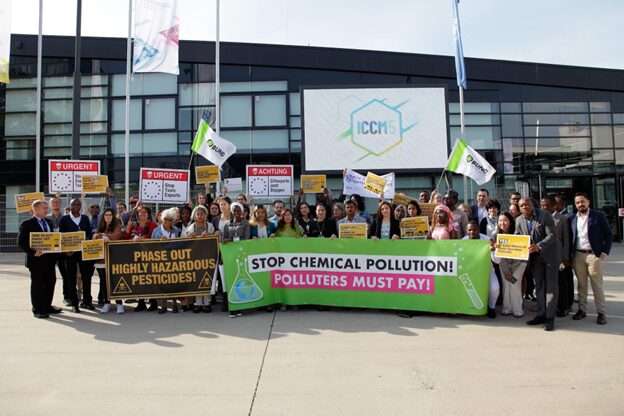
The adoption of the new Global Framework on Chemicals at ICCM5 marks a significant step in global chemicals and waste management, while promoting sustainability and safeguarding human rights. As the framework’s provisions are implemented and further developed, they will shape the future of global chemical management efforts.
This successor of SAICM Beyond 2020 is a testament to the needs and international efforts to prevent toxic threats and manage chemicals and waste more responsibly. The agreement provides a valuable roadmap for addressing critical global concerns in the realm of chemicals and waste management. It emphasizes transparency, accountability, and inclusivity in shaping the future of environmental governance. Furthermore, it highlights the interconnected challenges we face in addressing collectively the climate crisis, biodiversity loss, and the pervasive influence of fossil fuels. The transition from commitment to action is imperative, especially when considering the tangible impact on human health and human rights. CIEL, alongside its partners, stands ready to continue to advocate for, collaborate on, and ensure that the Global Framework on Chemicals translates into real-world improvements in human health, human rights, and environmental conditions. Together, we work towards a safer, healthier world for current and future generations.

